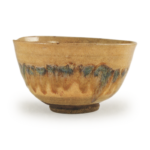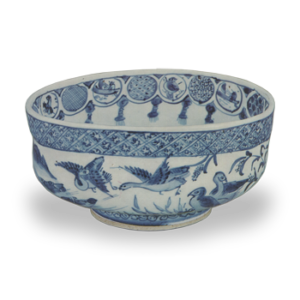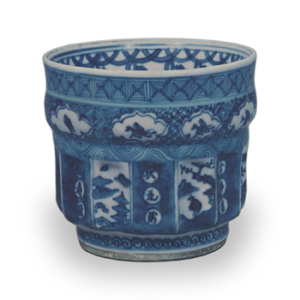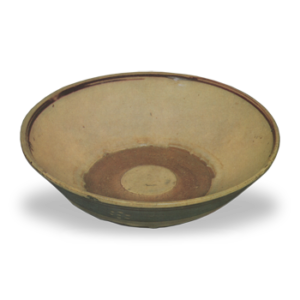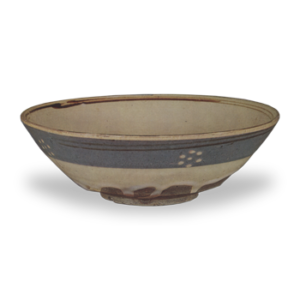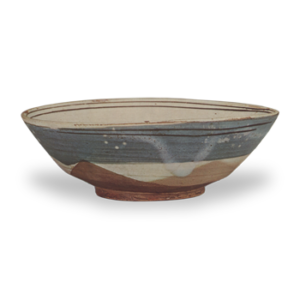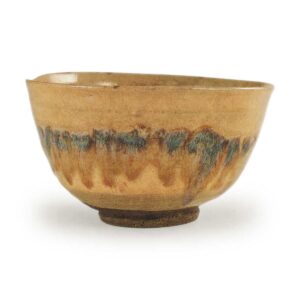
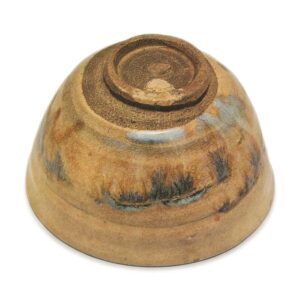
Chuko Meibutsu
Collection: Fujita Art Museum
Height: 8.0 – 8.7 cm
Diameter: 14.4 cm
Outer diameter of foot ring: 5.8 – 5.9 cm
Height of foot ring: 0.8 cm
The Haku-an tea bowl was named by Kobori Enshu after it was owned by Soya Haku-an, a doctor in the shogunate (who died in 1667 at the age of 62). The original tea bowl was later passed down to the Inaba family, who ruled the Yodo domain, and is now in the collection of the Nagoya Sekido family. Including the records, there are more than ten similar items, and the original, as well as the Fuki, Okuda, Toki and Kuchiki bowls, are famous for their restoration.
Regarding the Haku-an tea bowl, the original has a label saying “Seto tea bowl”, and the Enshu inscription on the Fuki tea bowl says “Seto Haku-an tea bowl”, while the Okuda tea bowl is inscribed “Seto Haku-an hand”. The “Mekirisou” and “Meikiroku” books identify it as Kise-to, and it has been known as a Seto tea bowl since Enshu.
The Hakuan tea bowl is said to have seven promises, ten vows, and twelve features, and it is said that the features to look out for are the unrefined clay, the loquat-colored glaze, the namihiyaku medicine, the thin foot ring, the bamboo-joint foot ring, the foot ring, the potter’s wheel marks, the small crackle, the flying glaze, and the tea The features of this type of ware are said to include a rough, earthy texture, a yellowish-brown glaze, a slightly curved shape, a horizontal groove in the middle of the body, and a sea-shell glaze, bamboo-joint foot ring, and in-glaze spatter on the foot ring, which are considered to be essential elements of Hakuande ware. However, as the same type of tea bowl, it is natural that the clay, glaze and style of making are the same, but the horizontal grooves on the body, the iron pigment (so-called nakago glaze) that holds these grooves, and the flying glaze inside the foot ring, etc., are probably the result of deliberate design, and it seems that they are reproductions that happen to resemble the original. In that sense, it seems that many similar bowls should be called a kind of shaped tea bowl.
Judging from the clay and glaze, it is appropriate to see it as a Seto-style bowl, but the style of the bamboo-jointed foot is incongruous. The curved rim and the bamboo joints are characteristic of the Karatsu style that was introduced from Korea, and in this respect, it seems that foreign elements have been added to the forming technique. During Hakuun’s lifetime, it was already possible to envisage such special cases, and judging from its unusual characteristics, it is probably safe to assume that this piece was made during Hakuun’s lifetime, around the Keicho era.
This Toki Hakuun piece has a bright yellow Seto glaze on the so-called “unfired clay” of Seto style, and there is a dent in one place on the rim of the mouth. There is a gutter running around the middle of the body, and this is sealed with iron pigment, which is then covered in yellow Seto glaze, revealing the beautiful nakago pattern, which is the highlight of the Haku-an tea bowl and is known as the nakago glaze. The foot is exposed below the rim, and the foot ring is thin and resembles bamboo joints, as in Karatsu ware. There is also the promised flying glaze from the rim to the inside of the bottom, and a helmet-shaped piece stands in the center, also in the style of Karatsu ware. It is worth noting that the traces of Karatsu-style techniques can be seen in the carving, and it is likely that it was formed by a Seto potter who had trained in Karatsu techniques, or by a Karatsu potter who was invited to Seto.
The shape is relaxed, and all of the so-called ten vows of the Haku-an style are present, and in particular, the sea cucumber, which is the most notable feature, is particularly splendid compared to others, and it should be called the excellence of the Haku-an tea bowl. The founder of the Tanimatsuya family, Toda Sōzō (died at the age of 79 in 1738), discovered it in Ise and presented it to the lord of the Numata domain, Toki Tango no Kami. It is called Toki Haku’an after the owner , and it is also mentioned in various tea books such as “Chaki Meibutsu Zushu”, “Meibutsu Chawan Shu”, and “Tanimatsuya Tekiire”. At the time of the Meiji Restoration, it passed from the Toki family to the hands of Tanimura Iemon of Osaka, and later passed to the Fujita family, and became a part of the Fujita Art Museum collection when the museum was established.

